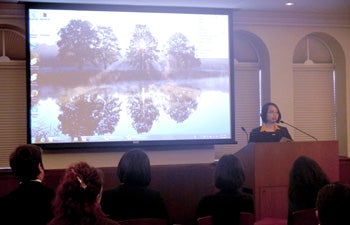Exhibiting Asia
In the first major event since USC joined forces with the Pacific Asia Museum in Pasadena, California, a two-day international symposium took place exploring a range of topics related to Asian art collections worldwide.
The “Ideas of Asia in the Museum” symposium occurred Jan. 23 and 24 and included guests from the United Kingdom, Italy, South Korea, Taiwan, Bhutan, and Israel. The first day was held in the Doheny Memorial Library on the USC University Park campus, with the second day in the Brown Auditorium at the Los Angeles County Museum of Art (LACMA).
Nearly 100 people attended each day.
“Now as part of the USC community, the Pacific Asia Museum has the potential of becoming a major hub to promote Asian art and culture in the L.A. area through innovative research and exhibition programs,” said Sonya Lee, associate professor of art history, East Asian languages and cultures, and religion at USC Dornsife, who organized the symposium with the Department of South and Southeast Asian Art at LACMA.
“As so many colleagues and institutions responded so positively to the symposium, I think we’ve made an important step toward realizing this goal.”

Sonya Lee of USC Dornsife, who helped organize the symposium celebrating the USC Pacific Asia Museum in Pasadena, California, speaks at the event. Photo by Stephanie Su.
In addition to USC faculty and students, colleagues in Asian art and Asian studies from universities, museums and research centers from Southern California and around the United States attended. The event also attracted the museum-going public, with a score of supporters, docents and visitors from local museums present.
“This made the gathering truly international in scope,” Lee said.
Since its inception in 18th-century Europe, the museum has provided modern societies with a powerful tool to display and define cultures of their own and those from around the world. This symposium brought together distinguished scholars and museum curators to examine the collecting and display of Asian art in relation to different ways of conceptualizing Asia in the geopolitical arena of the modern era.
Through six panels and a roundtable discussion, speakers and discussants explored the mechanisms and meanings in representing Asia through objects and artifacts inside the museum.
The event offered critical analyses of art institutions through the perspectives of colonialism, nationalism and capitalism. Some of the speakers examined the construction of narratives and conceptual frameworks in art history, anthropology, archaeology and Asian studies to explain and exhibit collections of art objects and cultural artifacts in museums. Throughout the event were lively discussions about the past developments and future of museum collections.
The symposium was supported by a grant from the American Council of Learned Societies, with additional funding from LACMA Education and Public Programs, USC East Asian Studies Center and USC Korean Studies Institute.
In 2013, USC partnered with the museum to form USC Pacific Asia Museum. The affiliation broadened the community that benefits from the museum’s role as a vital resource for education and cultural heritage, and expanded the audience interested in a dialogue about art, history and culture.